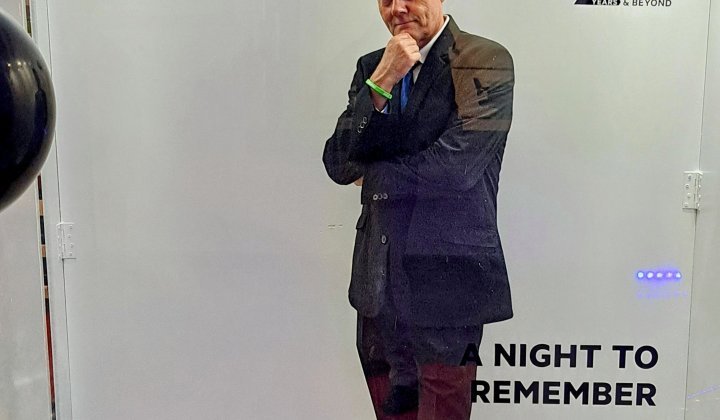South African Airways has a long and proud history as South Africa’s national carrier, and is considered a global ambassador for South African tourism.
But South Africa’s national carrier SAA is no stranger to turbulence. In the past 20-odd years it has faced numerous financial challenges, had more than 11 CEOs, been grounded due to Covid-19 and placed in business rescue. Since June 2021, the Takatso Consortium has been in negotiations to purchase a majority stake in the airline.
Despite Finance Minister Enoch Godongwana granting SAA R1 billion in the 2023 February budget, the department of public enterprises estimates that another R2.5-billion is needed to settle the airline’s total debt.
I was appointed interim CEO of the airline in March of 2021, with a mandate to restart the business and turn it around towards sustainability and profitability after it had been placed into business rescue by the department of public enterprises. I was also tasked with assisting the process of due diligence, with the aim of securing a potential strategic equity partner for the carrier.
The role involved contextualising interactions between the state, the business rescue practitioners, the existing board and management team, and the wider stakeholder universe of SAA. Additionally, I was stepping in at a time when the industry at large had been decimated by the Covid-19 pandemic.
Given the complexities associated with the management and governance of public entities, I was aware that the skills required to navigate through such organisations would be rather different.
Strategic challenges and business rescue
As the world of aviation has evolved over time, legacy carriers have lost their sense of exclusivity and guaranteed market access previously granted by governments who regarded the industry as an economic and geopolitical asset. The market evolution, which had made it easier for private enterprises to enter the market, meant that legacy airlines needed to adapt to a subsidy-free, competitive market.
Over the years SAA’s balance sheet became increasingly fragile on the back of poor profitability, and the status of the airline as a going concern became a persistent point of deliberation which required the state to provide subsidies and guarantees in order to enable the airline to meet its liquidity and solvency threshold.
Profits remained elusive and erratic due to deteriorating fundamentals of the business model, and SAA increasingly relied on recapitalisation from the state. While this enabled the airline to remain afloat, the persistent inability to reform its business model to ensure long-term viability meant the airline remained vulnerable and became an increasing burden on the fiscus.
Core to the problem was that subsidies served a purpose of honouring old commitments and operational requirements rather than investing in the future of the airline.
In December 2019 it became obvious that the airline could not pass the test of a going concern in light of the national government's decision to end all bailouts.
Such a decision reflected the culmination of the political disputes regarding the role of the airline in the economy, its strategic relevance and the questions of who ought to control its fortunes.
The business and commercial fundamentals of the aviation business had indicated that the SAA model was simply untenable. Business rescue represented an acknowledgement by the state that its ability to run an enterprise had fallen woefully short. The ideological reasons that had previously been advanced to justify the control of the airline – protection and preservation of jobs, the importance of a national flag carrier, and the perils of privatisation – were naturally found to have been collectively inadequate to keep the airline afloat and there was widespread scepticism about whether the airline could survive at all.
Privatisation or essential state asset?
Since the advent of democracy in 1994, the South African state has undergone a long and complicated journey in relation o tof the state’s involvement in business and what enterprises it should control and manage.
Throughout the world, state-owned enterprises (SOEs) are a common feature of the political economy and can be run sustainably. The creation and development of state enterprises is even more critical in developing countries where private markets are not deep enough to sustain nascent markets and network industries.
Governments on the other hand – with access to patient capital provided by taxpayers that can tolerate longer-term investment horizons – are often best-placed to initiate the development of key industries and major utilities such as energy, water and communications.
But this rationalisation may not apply to the ownership of an airline. The complexity of the journey was most acute in the case of SAA for a few reasons. While most of the large state enterprises are monopolistic giants that serve network industries, the aviation sector has undergone a major transformation in commercial terms since the early 1990s.
Its status as a state entity meant SAA’s policy directives and operational mode deferred to state rules and regulations as well as the Public Finance Management Act, which seeks to ensure that public resources are managed optimally, and citizens get value for all their resources and investment in public entities. The red tape associated with public entities makes it impossible for them to operate with the same type of agility as private sector players.
In the aviation industry, new business models that saw the introduction of new price points for the passenger market through low-cost offerings and new efficiencies in utilisation of aircraft amplified SAA’s strategic challenges. The critical costs of running an airline – labour, fuel and aircraft costs – continued to pose a persistent headache for the airline.
As publicly owned sectors mature and private enterprises emerge, the policy question that arises is whether the state should retain its involvement as an active market participant or yield to private enterprise. Such a process – where the state cedes its operational assets to market participants and concentrates on regulation – inevitably accelerates the privatisation of state assets.
Historically, there has been a sense of hostility towards privatisation among some members of government, especially when considering the position of SAA in within the larger portfolio of state assets.
For SAA to thrive, different political and commercial philosophies would have to be adopted in order to ensure a seamless transition not only into the global aviation network, but also the new business model of aviation where legacy airlines are fast losing currency.
Governance and leadership
The appropriate governance model for South Africa’s state enterprises portfolio has been a matter of contentious and ongoing debate. The state enterprises portfolio is made up of hundreds of entities of different scale, purpose and strategic importance.
What makes the entities unique is that the process of onboarding directors is a combination of political, commercial and policy considerations. However, conflicts between the commercial mandate and the socio-political mandate, lead to natural tensions in the system.
Core to the governance challenges at SAA and other state enterprises is the amplified role that politics play in the governance processes. Often, the approach to governance that overemphasised political considerations at the expense of other critical considerations.
The governance crisis that developed across state entities in the past decade harmed SAA and led to serious strategic errors that only worsened a fragile situation.
The consequence of the governance paralysis at SAA was the rapid decline in public accountability.
In the absence of a clear roadmap for how such organisations will be governed sustainably, the mixed model will prevail and – given its inherent limitations – will affect the ability of state enterprises to reach optimal governance and operational performance.
Recent developments at SAA
- In mid-May, the Competition Commission recommended the provisional approval of the proposed merger between SAA and Takatso Aviation.
- The month before, a new eight-member board was announced, this time chaired by former Minister of Tourism Derek Hanekom.
- This is the airline’s eighth board since 2009.
- Acting CEO and non-executive director John Lamola retained his position.
- At the time of writing, the proposed transaction for Takatso Consortium to purchase SAA was progressing, as the minority shareholders in the consortium had agreed to sell their stake.
- The transaction remains subject to approval from the competition authorities.
SAA CEOs through the years
- 2009 - Khaya Ngqula
After five years in the job, Ngqula was suspended and then fired following accusations that he authorised bonuses without proper approval. Former pilot Chris Smythe was appointed in an acting capacity. - 2010 - Siza Mzimela
Mzimela was appointed as CEO in 2010. She joined SAA in 1996 as a research analyst. - 2012 - Vuyisele Kona
Mzimela resigned following a dispute with government and was replaced by SAA chairperson Vuyisele Kona. - 2013 - Nico Bezuidenhout
Then minister of public enterprises Malusi Gigaba suspended Kona following unnamed allegations. Nico Bezuidenhout, CEO of Mango, was appointed as acting CEO. - 2013 - Monwabisi Kalawe
Bezuidenhout is replaced by a new permanent CEO Kalawe. - 2014 - Nico Bezuidenhout
Kalawe is suspended, and Bezuidenhout is again appointed as CEO. - 2015 - Thuli Mpshe, Musa Zwane
HR head Thuli Mpshe is appointed acting CEO. She is replaced in the same year by Musa Zwane, the new acting CEO. - 2017- Vuyani Jarani
Zwane is suspended amid accusations of facilitating questionable payments. Former Vodacom executive Vuyani Jarani was named as permanent CEO. - 2019 - Zukisa Ramasia
Jarana resigns, citing a lack of government support. The board appointed Zukisa Ramasia as acting CEO. - 2020 - Philip Saunders
Ramasia goes into early retirement, replaced by Saunders as Interim CEO. His contract was not renewed. - 2021 - Thomas Kgokolo
Kgokolo appointed interim CEO. - 2022 John Lamola
Previous head of Denel Aviation, Lamola was appointed SAA CEO and executive chair at the beginning of 2022. He held the position at time of publishing.
Editor’s Note
A word on state capture and corruption
Allegations of corruption and state capture at SAA were well documented during the course of the Judicial Commission of Inquiry into Allegations of State Capture, or Zondo Commission.
SAA's governance and leadership challenges, however, predate these allegations and the tenure of former South African Airways chair Dudu Myeni.
In his final report, Chief Justice Raymond Zondo said fraud and corruption had been allowed to become endemic at the airline and recommended that the National Prosecuting Authority further investigate and possibly prosecute a number of former SAA employees who held senior positions, including Myeni, who is accused of having "sabotaged" the airline from within.
In its response to the report, the SAA board and executives said they "respect the work of the Commission and [are] currently examining the Zondo State Capture Commission's report."
The interim board of SAA says it intends to institute internal investigations and disciplinary processes with the aim of "cleaning the company of all vestiges of its shameful past" as exposed in the Zondo Commission's report.
Thomas Kgokolo
Thomas Kgokolo CA (SA) was previously interim chief executive officer of South African Airways during 2021 and was responsible for transitioning the airline out of business rescue. His new book about his time at the national carrier will be available later in 2023. Kgokolo lectures in finance and strategy at GIBS.




